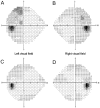Macroprolactinoma in an adolescent female with primary amenorrhoea
- PMID: 39713937
- PMCID: PMC11737432
- DOI: 10.1530/EDM-24-0033
Macroprolactinoma in an adolescent female with primary amenorrhoea
Abstract
Summary: Paediatric pituitary adenomas are rare in children and adolescents and differ from adults in both clinical presentation and management. We present the case of a 14-year-old female with primary amenorrhoea secondary to a macroprolactinoma, showing a modest radiological and biochemical response to dopamine agonist (DA) therapy. Despite a 10-month duration of increasing DA therapy, initial symptoms of primary amenorrhoea and hyperprolactinaemia persisted, with new symptoms of weight gain, lethargy and low mood. A transsphenoidal resection of the macroprolactinoma was successfully performed, followed by the initiation of additional hormonal therapy. This case explores the unique challenges of treating a macroprolactinoma refractory to medical management in adolescence.
Learning points: Management of macroprolactinomas in childhood and adolescence can bring unique challenges, including a delay in sexual development, often presenting with primary or secondary amenorrhoea in girls.DA therapy is typically the first-line therapy in treating macroprolactinomas; however, resistance in paediatric and adolescent patients is associated with tumour size and initial prolactin levels.Surgical resection should be considered as a second-line therapy for adolescents unable to tolerate high-dose DA therapy or have inadequate response to DA therapy.There are a range of potential surgical complications, including permanent or transient diabetes insipidus, meningitis, cerebrospinal fluid leakage and hypopituitarism.Timely management of macroprolactinomas is important for secondary sex characteristics, bone development and psychological well-being.
Keywords: adolescent; macroprolactinoma; pituitary.
Conflict of interest statement
The authors declare that there is no conflict of interest that could be perceived as prejudicing the impartiality of the work.
Figures




Similar articles
-
Recurrence of hyperprolactinaemia following discontinuation of dopamine agonist therapy in patients with prolactinoma occurs commonly especially in macroprolactinoma.Clin Endocrinol (Oxf). 2011 Dec;75(6):819-24. doi: 10.1111/j.1365-2265.2011.04136.x. Clin Endocrinol (Oxf). 2011. PMID: 21645021
-
Macroprolactinomas in children and adolescents: factors associated with the response to treatment in 77 patients.J Clin Endocrinol Metab. 2015 Mar;100(3):1177-86. doi: 10.1210/jc.2014-3670. Epub 2014 Dec 22. J Clin Endocrinol Metab. 2015. PMID: 25532043
-
Multiple Endocrine Neoplasia Type 1 (MEN1) Presenting as an Invasive Macroprolactinoma Complicated by Acute Bacterial Meningitis.Cureus. 2021 Dec 1;13(12):e20086. doi: 10.7759/cureus.20086. eCollection 2021 Dec. Cureus. 2021. PMID: 34993034 Free PMC article.
-
Diagnosis and drug therapy of prolactinoma.Drugs. 1996 Jun;51(6):954-65. doi: 10.2165/00003495-199651060-00004. Drugs. 1996. PMID: 8736617 Review.
-
Prolactinoma in childhood and adolescence-Tumour size at presentation predicts management strategy: Single centre series and a systematic review and meta-analysis.Clin Endocrinol (Oxf). 2021 Mar;94(3):413-423. doi: 10.1111/cen.14394. Epub 2020 Dec 26. Clin Endocrinol (Oxf). 2021. PMID: 33340135
References
LinkOut - more resources
Full Text Sources

